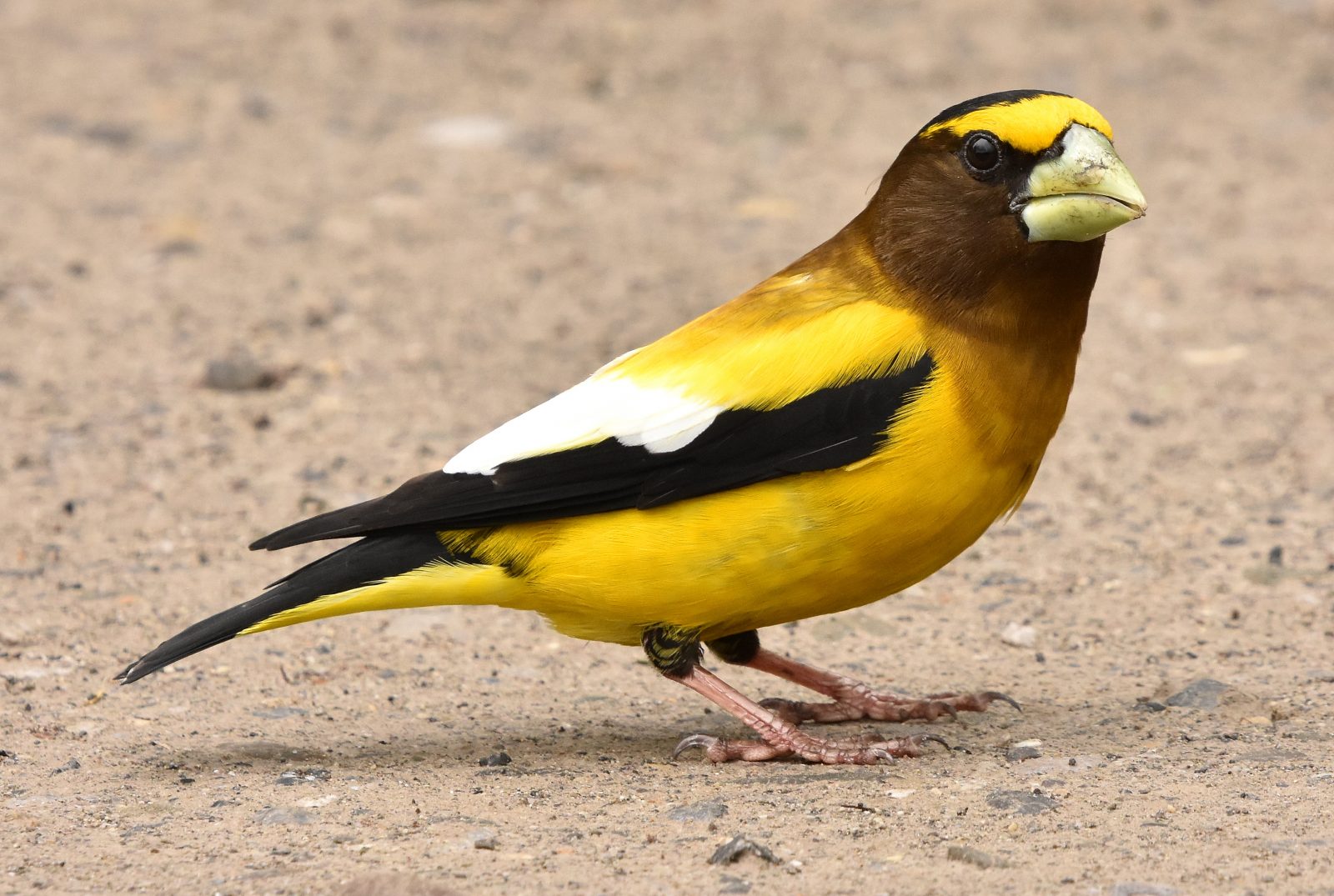During the spring and summer seasons in South Dakota, when the warblers make their arrival, it is quite common to spot yellow birds, particularly the American Goldfinch. However, in the winter months, the American Goldfinch stands as the only prevalent yellow bird in the area.
If you have come across any yellow birds in South Dakota and are eager to identify them, this guide will prove immensely helpful. It presents you with an array of resources including pictures, identification details, song recordings, and migration patterns.
In South Dakota, most yellow birds belong to the warbler, oriole, or tanager families. Interestingly, female birds within these species may exhibit significant differences in appearance compared to their male counterparts.
To facilitate the identification process, the guide lists the yellow birds in order of their common occurrence in South Dakota during spring and summer months, as reported by ebird checklists for May and June.
Yellow birds that can be found in South Dakota throughout the year include the American Goldfinch and Cedar Waxwing.
During the summer, additional yellow birds in South Dakota include the Western Meadowlark, Yellow Warbler, Yellow-rumped Warbler, Common Yellowthroat, Yellow-headed Blackbird, Western Kingbird, Baltimore Oriole, Orchard Oriole, Dickcissel, American Redstart, Western Tanager, Yellow-throated Vireo, Palm Warbler, Scarlet Tanager, Blue-winged Warbler, and Lesser Goldfinch.
Yellow birds that can be observed during migration periods in South Dakota include the Orange-crowned Warbler, Wilson’s Warbler, Nashville Warbler, Magnolia Warbler, Palm Warbler, Canada Warbler, Black-throated Green Warbler, Evening Grosbeak, Cape May Warbler, Pine Warbler, and Prothonotary Warbler.
So, if you’re eager to identify the yellow birds you’ve spotted, continue reading this guide for valuable insights.
Here are 29 yellow birds you can find in South Dakota:
1. Western Meadowlark
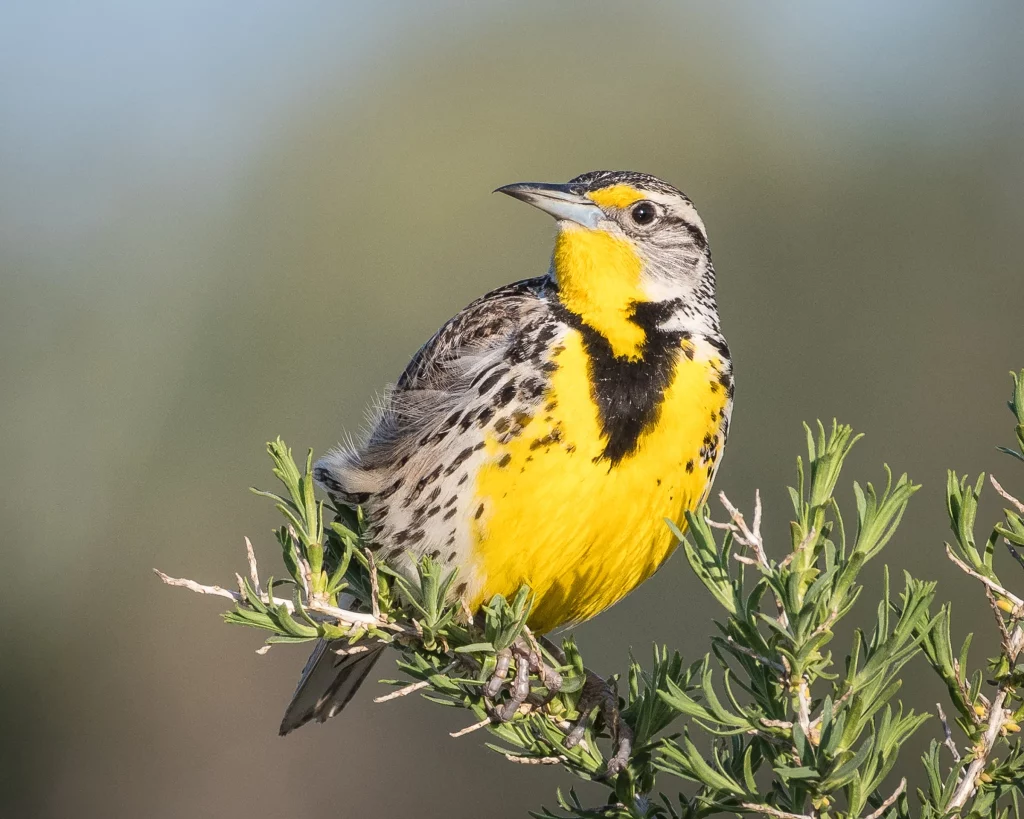
Western Meadowlarks are the most commonly sighted yellow birds during the breeding season in South Dakota. They appear in approximately 32% of summer checklists submitted by birdwatchers. Although most migrate to more southern states in winter, a few remain in the southern regions of South Dakota throughout the year.
With their vibrant yellow bellies and melodious songs, Western Meadowlarks have the ability to brighten anyone’s day. They belong to the blackbird family and resemble the size of a Robin, boasting shades of brown and white on their upper body parts. Their bright yellow chests showcase a distinctive black V-shaped band that turns gray during the winter months.
Sturnella neglecta
Length: 6.3-10.2 in (16-26 cm)
Weight: 3.1-4.1 oz (89-115 g)
Wingspan: 16.1 in (41 cm)
These Meadowlarks that breed in the northern states of the US and Canada migrate during winter, while those found in the western and midwestern regions remain in South Dakota year-round.
Typically, you can spot Western Meadowlarks foraging on the ground in grasslands, meadows, and fields. They prefer to hunt for food alone or in small flocks, and you won’t often find them in wooded areas or dense shrubbery.
Their diet primarily consists of insects during the summer months, shifting towards seeds and grain during winter.
If you’re interested in hearing the delightful tweets, warbles, and whistles of Western Meadowlarks, you can find their unique sounds in the provided link. Additionally, there’s a video available showcasing the beauty of their melodic calls.
Western Meadowlarks construct their nests in ground depressions found in grasslands. These nests are carefully filled with soft materials such as grass and occasionally possess a grass and plant stalk roof.
If you wish to attract Western Meadowlarks to your backyard, try offering them sunflower seeds and cracked corn.
An intriguing fact: Western Meadowlarks have been designated as the state bird in six US states.
2. American Goldfinch

American Goldfinches can be observed in South Dakota throughout the year. They appear in 26% of summer checklists and 20% of winter checklists submitted by birdwatchers.
These Goldfinches are highly favored due to their captivating appearance. During the spring season, males boast vibrant black and yellow plumage, while females and males during the winter display more subdued brown coloring.
Spinus tristis
Length: 4.3-5.1 in (11-13 cm)
Weight: 0.4-0.7 oz (11-20 g)
Wingspan: 7.5-8.7 in (19-22 cm)
American Goldfinches can be found across most of North America and are usually permanent residents. However, those breeding in Canada and the Midwest migrate to southern states of the US during winter.
You can spot American Goldfinches in weedy fields, overgrown areas, suburbs, parks, and even your own backyard. They primarily forage on sunflower, thistle, and aster plants.
If you’re curious about their unique song, you can listen to it through the provided link.
American Goldfinch nests are typically located in saplings or shrubs. Constructed from grass, bark strips, and feathers, these nests serve as a home for the female to lay four to six eggs. The eggs take around ten to twelve days to hatch, during which the male feeds the female.
To attract American Goldfinches to your backyard, consider planting thistles and milkweed. They are known to visit most bird feeders and prefer sunflower and nyjer seeds.
A fascinating fact: Brown-headed Cowbirds often lay their eggs in American Goldfinch nests. Unfortunately, the seed-based diet that the parents feed the cowbird chicks is unsuitable for their survival, leading to their eventual demise.
3. Yellow Warbler
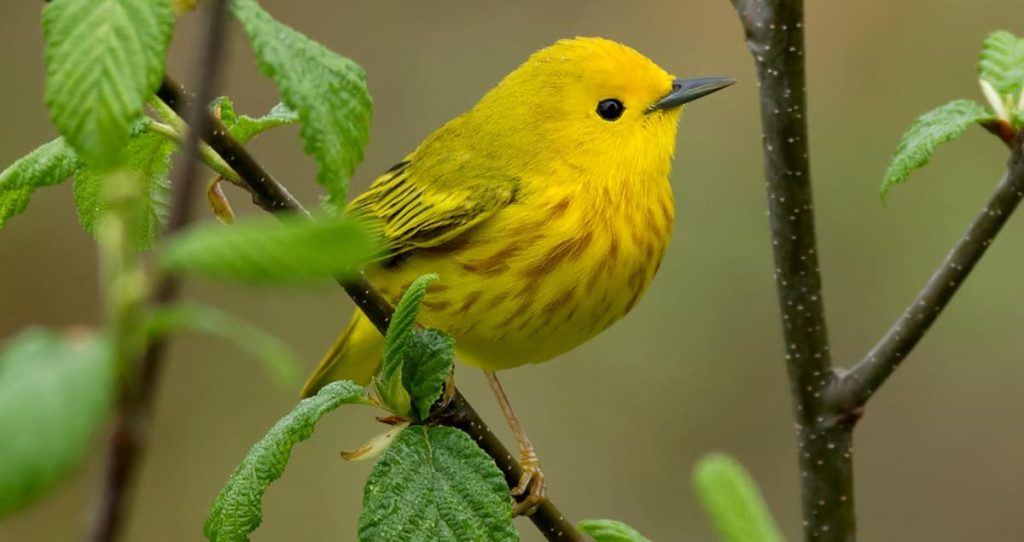
Yellow Warblers rank as the third most commonly spotted yellow birds during the breeding season in South Dakota. They are typically observed from May to October and can be found in 21% of summer checklists.
These small, bright yellow birds possess yellow-green backs, with males exhibiting chestnut streaks on their breasts. Females and juveniles tend to display less vibrant colors compared to the males.
Setophaga petechia
Length: 4.7-5.1 in (12-13 cm)
Weight: 0.3-0.4 oz (9-11 g)
Wingspan: 6.3-7.9 in (16-20 cm)
Yellow Warblers migrate long distances to breed in Canada and the US, excluding southeastern states. They then embark on their journey to Central and South America for the winter season. However, they can be sighted during migration in southeastern US states.
You’ll typically find Yellow Warblers in proximity to streams, wetlands, thickets, and field edges, foraging for insects such as caterpillars, midges, beetles, bugs, and wasps.
For an immersive experience of their unique song, you can listen to it via the provided link.
Nests of Yellow Warblers are usually situated in small trees or shrubs, composed of bark, grass, and plant materials intricately woven together and secured with spider webs. These nests are then lined with softer materials like hair, feathers, and plant down.
The female Yellow Warbler lays up to seven eggs, which take approximately twelve days to hatch. It takes an additional ten days for the young birds to leave the nest.
To attract Yellow Warblers to your backyard, consider providing suet, oranges, peanut butter, and plants with berries. Planting native species that attract insects without the use of pesticides and maintaining a more natural landscape can also entice them. Additionally, birdbaths with fountains near secluded planting areas offer protection for these beautiful birds.
Did you know? When Cowbirds lay their eggs in Yellow Warbler nests and are detected, the Yellow Warblers build a new nest on top of the old one, restarting the nesting process up to six times!
4. Cedar Waxwing
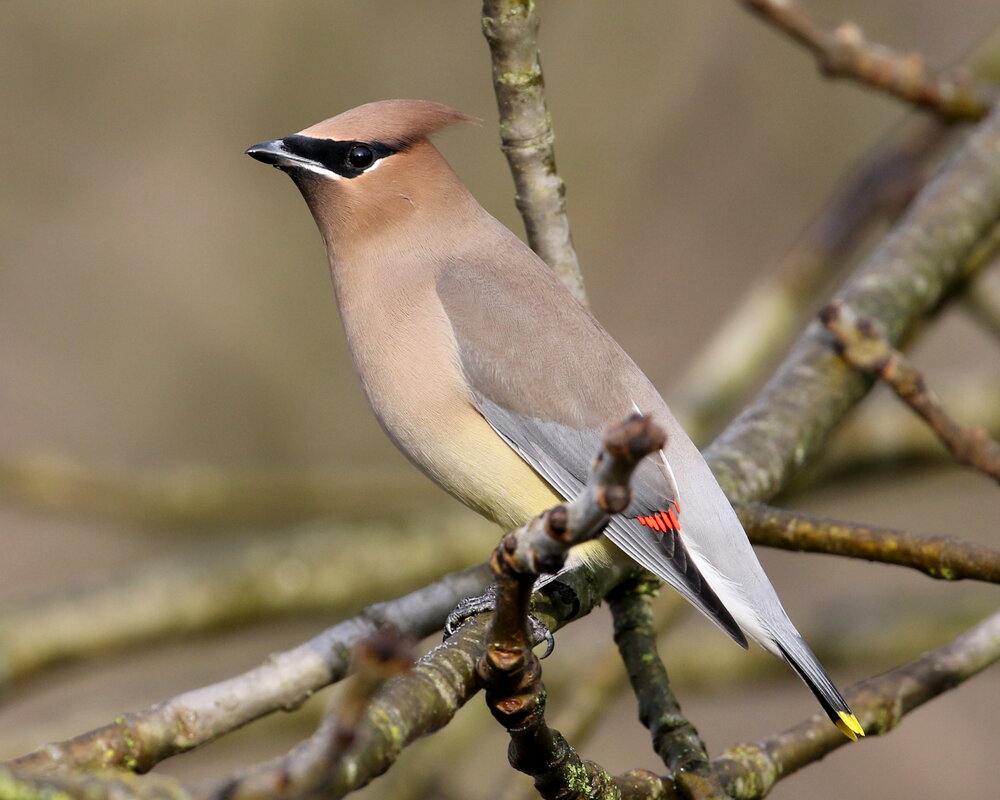
Cedar Waxwings are more commonly sighted in South Dakota during the breeding season, although some remain year-round. They appear in 9% of summer checklists and 5% of winter checklists.
Elegant and social, Cedar Waxwings exhibit pale brown coloring on their heads, chests, and crests, transitioning to gray on their backs, wings, and tail. Their bellies showcase a pale yellow shade, while bright yellow accents grace the tips of their wings. They sport a narrow black mask across their eyes and bright red wingtips.
Bombycilla cedrorum
Length: 5.5-6.7 in (14-17 cm)
Weight: 1.1 oz (32 g)
Wingspan: 8.7-11.8 in (22-30 cm)
Cedar Waxwings breed in Canada and migrate to southern US states, Mexico, and Central America for winter. However, some individuals remain year-round in the northern US states.
You can spot Cedar Waxwings in berry bushes, woodlands, grasslands, towns, and along streams. Their diet primarily consists of fruit, but they also consume insects during the summer season.
Curious about the sounds of Cedar Waxwings? You can listen to their distinctive calls through the provided link.
Nests of Cedar Waxwings are constructed using twigs, grass, hair, and plant material. These nests are lined with pine needles and soft grass. The female lays up to six eggs, requiring around twelve days to hatch. The young birds take approximately sixteen days to leave the nest.
To attract Cedar Waxwings to your backyard, consider planting native trees and shrubs that bear small fruits such as serviceberry, dogwood, juniper, winterberry, and hawthorn. You can also try offering fruit on platform feeders.
An interesting fact: Cedar Waxwings engage in gift-giving behaviors during courtship, passing objects between potential mates.
5. Yellow-rumped Warbler

Yellow-rumped Warblers spend the breeding season in South Dakota, but their numbers increase during migration in May and October. They appear in 12% of summer checklists and up to 29% of checklists during migration.
Gray with yellow flashes on their face, sides, and rump, Yellow-rumped Warblers also display white in their wings. Females may exhibit a slightly brown hue, while winter birds appear as paler brown with bright yellow rumps and sides, transitioning back to yellow and gray during spring.
Setophaga coronata
Length: 4.7-5.5 in (12-14 cm)
Weight: 0.4-0.5 oz (12-13 g)
Wingspan: 7.5-9.1 in (19-23 cm)
Yellow-rumped Warblers predominantly breed in Canada, parts of the Rockies, and the Appalachian mountains. During migration, they can be observed in the Midwest. In winter, they can be found in open areas with fruiting shrubs, migrating to southern and
southwestern US states, the Pacific Coast, Mexico, and Central America.
You can spot Yellow-rumped Warblers in coniferous forests, particularly during the breeding season. In winter, they frequent open areas with fruiting shrubs. Their diet consists mainly of insects during summer and transitions to fruit consumption, including bayberry and wax myrtle, during migration and winter.
For a delightful auditory experience of the Yellow-rumped Warbler’s song, follow the provided link.
Nests of Yellow-rumped Warblers are crafted by females in conifer trees using twigs, pine needles, and grass. The nests are lined with soft grass, moss, and hair. The female lays up to six eggs, which take around two weeks to hatch. The young birds require an additional two weeks before leaving the nest.
To attract Yellow-rumped Warblers to your backyard, provide sunflower seeds, suet, raisins, and peanut butter.
An intriguing fact: Yellow-rumped Warblers form flocks numbering in the thousands during winter and can exhibit aggression toward other species that encroach upon their space.
6. Common Yellowthroat
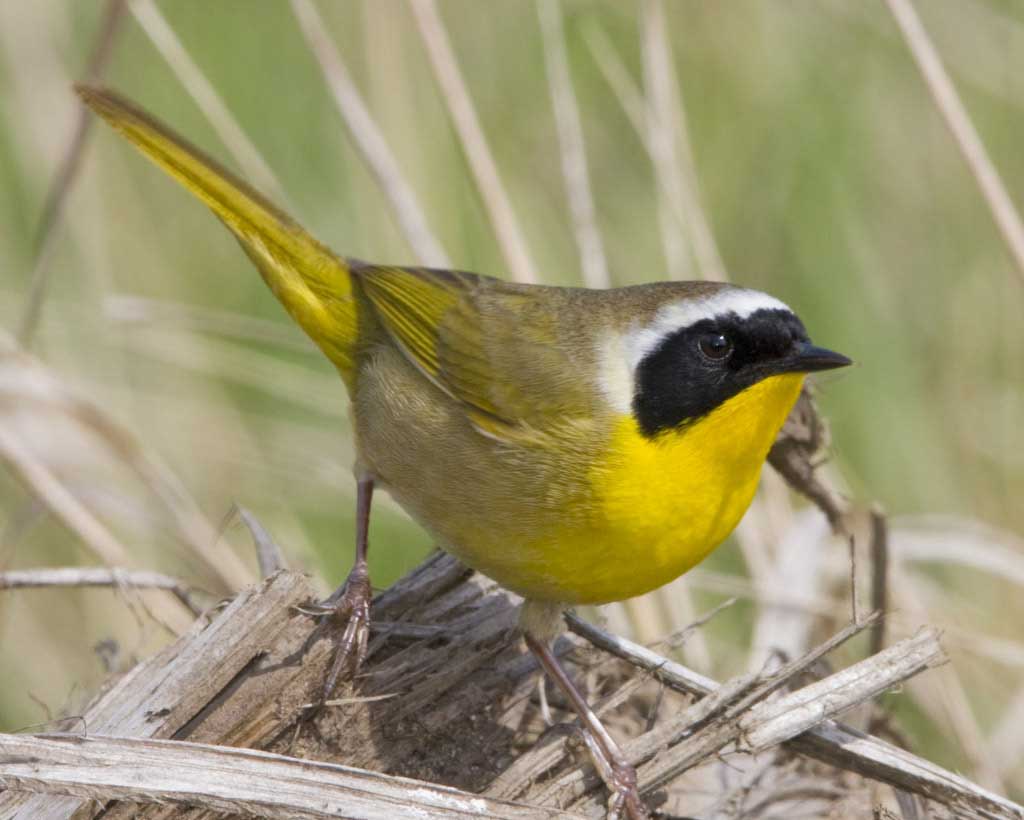
Common Yellowthroats can be observed in South Dakota during the breeding season, appearing in 16% of summer checklists. They are typically seen from May to October.
These small songbirds possess brownish backs and bright yellow underparts, featuring long tails. Males display black masks across their faces. The brightness of the yellow plumage may vary geographically, and individuals in certain regions may showcase a more olive coloration underneath.
Geothlypis trichas
Length: 4.3-5.1 in (11-13 cm)
Weight: 0.3-0.3 oz (9-10 g)
Wingspan: 5.9-7.5 in (15-19 cm)
Common Yellowthroats spend their summers breeding across most of North America, excluding Alaska and northern Canada. Some individuals remain year-round along the Gulf Coast and Pacific Southwest, while others migrate south for winter.
You can often find Common Yellowthroats in marshy or wetland areas, as well as brushy fields with thick, tangled vegetation.
For a sample of their distinctive song, you can listen to the provided link.
Nests of Common Yellowthroats are built by females near the ground in marshy areas, supported by reeds. These nests are composed of grass and sedges, with a foundation of leaves and grass. They lay up to six eggs, taking around twelve days to hatch, and an equivalent duration for the young birds to leave the nest.
To attract Common Yellowthroats to larger backyards, ensure dense vegetation and plant native species that attract insects.
An interesting fact: The black mask on Common Yellowthroats serves as a visual cue to courting males, leading them to attack when artificial birds lacking the mask are used, while remaining non-aggressive in their absence.
7. Yellow-headed Blackbird
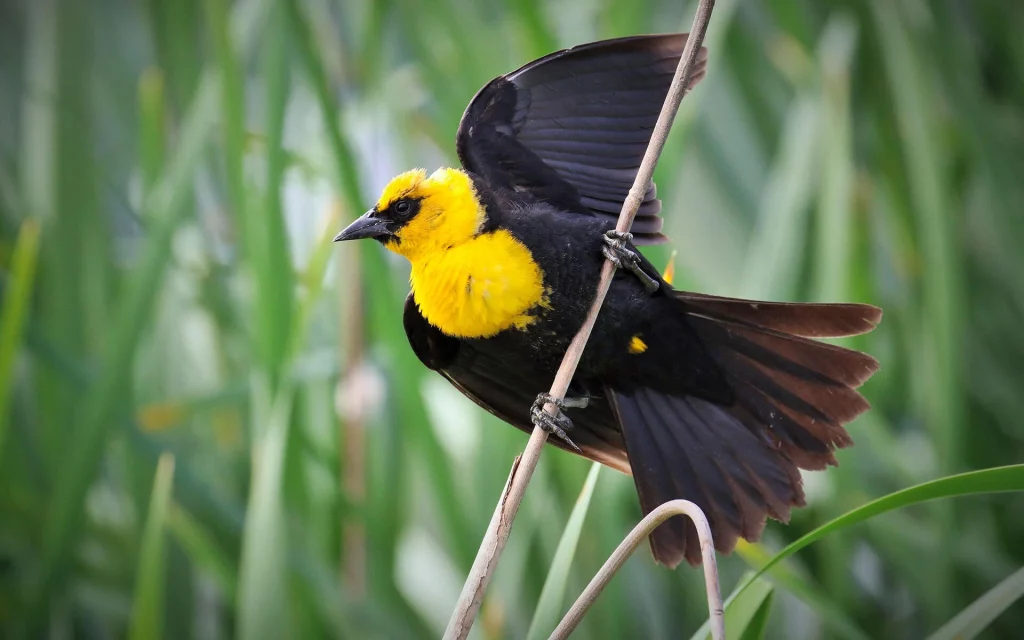
Yellow-headed Blackbirds spend their summers in South Dakota, mainly from March to November. They are recorded in 13% of summer checklists.
These blackbirds possess glossy black bodies, vibrant yellow heads and chests, and white patches on their wings in males. Females exhibit a brown coloration instead of black, with a duller yellow head. They are larger than Red-winged Blackbirds.
Xanthocephalus xanthocephalus
Length: 8.3-10.2 in (21-26 cm)
Weight: 1.6-3.5 oz (44-100 g)
Wingspan: 16.5-17.3 in (42-44 cm)
Yellow-headed Blackbirds breed in western and prairie wetlands, constructing nests among the reeds. They forage in
the surrounding wetlands, grasslands, and fields, primarily feeding on insects during the summer season.
After breeding, Yellow-headed Blackbirds migrate to fields and farmlands in Southwest states and Mexico, forming large flocks for the winter.
Their diet consists of insects in summer and transitions to seeds and grains during winter.
For a glimpse of their unique sounds, including a screeching buzz, follow the provided link.
Nests of Yellow-headed Blackbirds are constructed using long, wet stems woven together and attached to cattails or reeds above the water. They lay 2 to 5 eggs, requiring approximately two weeks to hatch, and another week or two before the young birds fledge.
To attract Yellow-headed Blackbirds to your yard, offer sunflower seeds.
An interesting fact: Yellow-headed Blackbirds flip over stones to flush out insects, using this method for hunting.
8. Western Kingbird
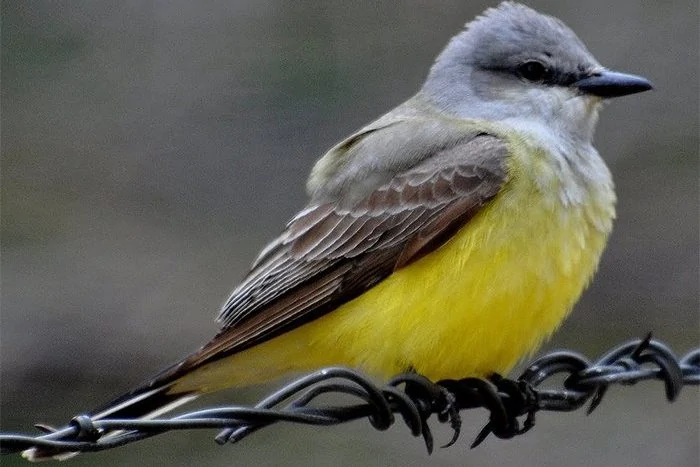
Western Kingbirds are sighted in South Dakota during the summer, from April to September, appearing in 13% of checklists during this period.
These large flycatchers feature yellow bellies, whitish chests, gray heads, grayish-brown wings, and black tails with white edges.
Tyrannus verticalis
Length: 7.9-9.4 in (20-24 cm)
Weight: 1.3-1.6 oz (37-46 g)
Wingspan: 15.0-16.1 in (38-41 cm)
Western Kingbirds breed in summer across western US states, the plains area, and into Canada. They migrate to Mexico and Central America during the colder months, while some individuals may overwinter in southern Florida.
You can spot Western Kingbirds in open habitats, often perched on fences and utility lines, waiting to catch insects in mid-flight.
For an auditory experience of Western Kingbird calls, click on the provided link.
Nests of Western Kingbirds are usually built in trees or shrubs, although they may also nest in human-made structures. The female constructs the nest using twigs, grass, and plant materials, creating a cup-shaped structure.
They lay up to seven eggs, which take two to three weeks to hatch, with a similar duration before the young birds leave the nest.
To attract Western Kingbirds to your yard, create an insect-friendly environment and consider planting elderberry or hawthorn trees. These birds also consume the fruit from these trees.
A fascinating fact: Western Kingbird parents continue to feed their young for an additional three weeks after they leave the nest.
9. Baltimore Oriole (Female)

Baltimore Orioles spend their summers in South Dakota, from May to September, and are present in 12% of checklists during this time.
Baltimore Orioles serve as colorful signs of spring in the eastern regions of North America. Adult males exhibit bright orange and black plumage, with white wing bars on their black wings.
Females display yellowish hues on the underside and head, along with grayish-brown wings. Their backs feature a brownish-yellow shade. These orioles are about the size of a Robin but possess a more slender build. They belong to the blackbird family.
Icterus galbula
Length: 6.7-7.5 in (17-19 cm)
Weight: 1.1-1.4 oz (30-40 g)
Wingspan: 9.1-11.8 in (23-30 cm)
Baltimore Orioles breed in Eastern and Central states, including central-southern Canadian provinces and the southern US border. For winter, they migrate to Florida, Central America, and the Caribbean, often departing as early as July.
You can find Baltimore Orioles in open woodlands, along riverbanks, and forest edges, as well as in parks and backyards. They forage for insects and consume a wide variety of fruits. However, they can cause damage to crops such as raspberries, mulberries, cherries, bananas, and oranges.
For a delightful auditory experience of the flute-like sound produced by Baltimore Orioles, follow the provided link. They also emit chattering and sharp alarm calls.
To attract Baltimore Orioles to your backyard, offer cut oranges or mangoes on a platform feeder or hang them from trees. Oriole feeders filled with sugar water can also entice them. Planting fruiting plants and nectar-producing flowers, such as raspberries, crab apples, and trumpet vines, will further attract these birds.
A fascinating fact: Baltimore Orioles construct incredible hanging bag-like nests woven from fibers.
10. Orchard Oriole (Female)
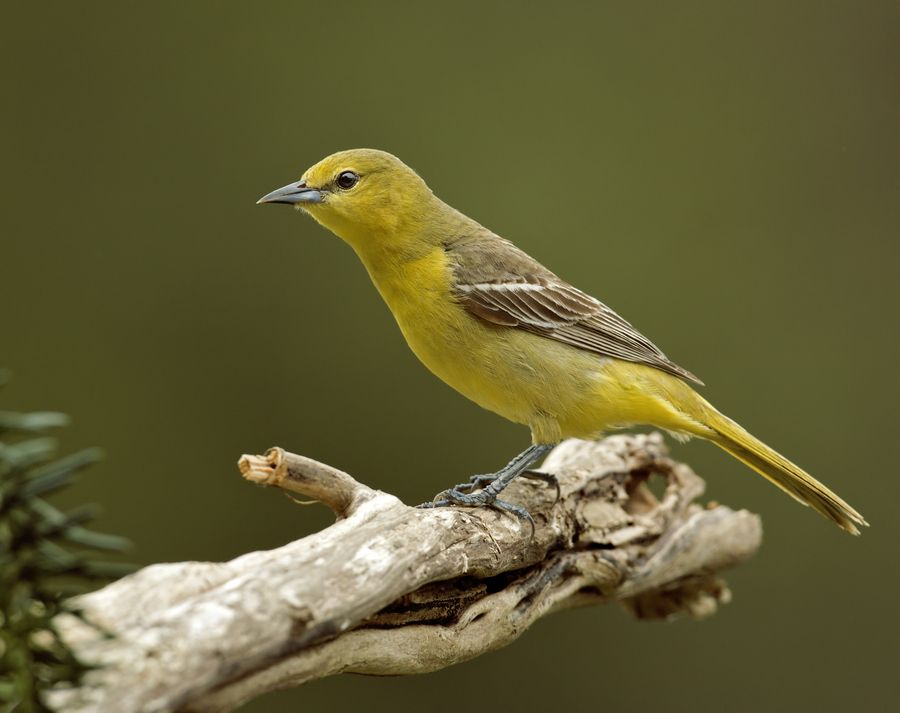
Orchard Orioles inhabit South Dakota during the summer months, from May to September, appearing in 12% of checklists during this period.
Female Orchard Orioles display a greenish-yellow overall coloration, with a paler underside and darker back, along with darker wings and white wingbars.
Icterus spurius
Length: 5.9-7.1 in (15-18 cm)
Weight: 0.6-1.0 oz (16-28 g)
Wingspan: 9.8 in (25 cm)
During summer, Orchard Orioles breed in the eastern half of the United States, migrating south to Mexico and Central America.
Orchard Orioles prefer open woodlands and can also be found along riverbanks, open shrublands, farms, and backyards. They construct hanging, pouch-like nests.
Their diet primarily consists of insects, such as ants, caterpillars, beetles, and grasshoppers. They also consume nectar from flowers and feed on fruits like mulberries and chokeberries.
For a sample of their distinctive whistling song, listen to the provided link.
Nests of Orchard Orioles are cup-shaped structures made from long grasses and suspended from small branches of trees. These nests are lined with pine needles and soft grass. They lay 4 to 6 eggs, which require around two weeks to hatch.
To attract Orchard Orioles to your yard, provide hummingbird feeders or platform feeders with cut oranges or mangoes. Planting native berry-producing trees and shrubs, such as mulberries or chokeberries, will also prove enticing.
An intriguing fact: Orchard Orioles are the smallest blackbird species in North America.
11. Dickcissel
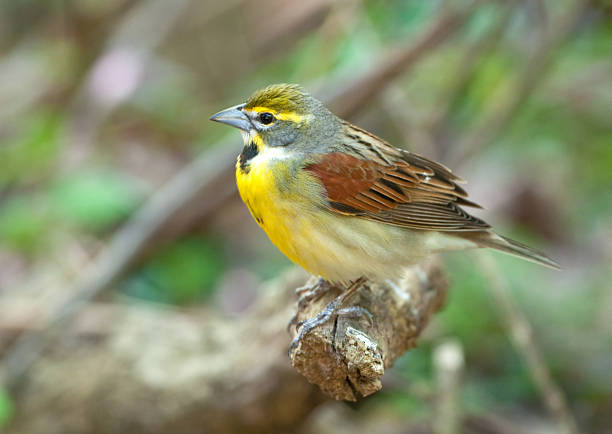
Dickcissels are commonly seen in South Dakota during the summer breeding season, from May to August, and appear in 8% of checklists during this time.
These small birds have a yellowish breast, a grayish-brown back, and a distinctive black patch on their throat. Males display a yellow crown and a black V-shaped mark on their chest, while females have a paler version of these markings.
Spiza americana
Length: 5.5-6.3 in (14-16 cm)
Weight: 0.6-0.7 oz (18-21 g)
Wingspan: 9.4-10.2 in (24-26 cm)
Dickcissels breed across the central and eastern parts of the United States, as well as into southern Canada. During the winter, they migrate to Central and South America.
These birds prefer grasslands, meadows, and fields with tall vegetation, where they feed on insects, seeds, and grains.
For a sample of the Dickcissel’s unique buzzing song, listen to the provided link.
Nests of Dickcissels are built on the ground, typically concealed within grasses. The female constructs the nest using grass, leaves, and stems, forming a cup-shaped structure. They lay 3 to 5 eggs, which require approximately two weeks to hatch.
To attract Dickcissels to your yard, provide open areas with tall grasses and native wildflowers that can supply seeds and insects for their diet.
Interesting fact: The name “Dickcissel” is derived from the sound of their distinctive song, which is often described as a buzzing “dick-cissel.”
12. American Redstart

American Redstarts are migratory birds that can be seen in South Dakota during the summer breeding season, from May to August. They appear in 7% of summer checklists.
These small, active birds have striking black and orange plumage. Males display black upperparts, a bright orange breast, and white patches on their wings and tail. Females, on the other hand, have grayish upperparts and yellowish underparts.
Setophaga ruticilla
Length: 4.3-5.1 in (11-13 cm)
Weight: 0.3-0.4 oz (9-11 g)
Wingspan: 6.7-7.9 in (17-20 cm)
American Redstarts breed in the eastern and central parts of North America, from southern Canada to the southeastern United States. They migrate to Central and South America for the winter.
These birds can be found in deciduous and mixed forests, as well as in shrubby areas near water. They are known for their aerial insect-catching abilities.
For a melodious sample of the American Redstart’s song, follow the provided link.
Nests of American Redstarts are built in shrubs or low branches of trees, usually located a few feet above the ground. The female constructs the nest using twigs, grass, bark, and leaves. They lay 3 to 5 eggs, which take approximately two weeks to hatch.
To attract American Redstarts to your yard, create a diverse habitat with trees, shrubs, and water sources. Providing insects and maintaining a pesticide-free environment will support their foraging needs.
Interesting fact: Male American Redstarts perform a unique “wing-flicking” behavior during courtship displays, flashing their vibrant orange patches to attract females.
13. Western Tanager

Western Tanagers can be spotted in South Dakota during the summer breeding season, primarily from May to August. They appear in 6% of summer checklists.
These medium-sized birds have bright yellow bodies,
black wings, and distinctive reddish-orange heads. Females have a more subdued appearance, with olive-yellow plumage instead of bright yellow.
Piranga ludoviciana
Length: 6.3-7.5 in (16-19 cm)
Weight: 0.8-1.2 oz (24-34 g)
Wingspan: 9.8-11.4 in (25-29 cm)
Western Tanagers breed in the western parts of North America, from southern Alaska to central Mexico. They migrate to Mexico and Central America for the winter.
These birds can be found in coniferous forests, open woodlands, and mountainous regions. They feed on insects, fruits, and nectar.
For a delightful auditory experience of the Western Tanager’s song, listen to the provided link.
Nests of Western Tanagers are built in conifer trees, usually located near the trunk and supported by horizontal branches. The female constructs the nest using twigs, grass, and leaves, lined with softer materials such as feathers and plant down. They lay 3 to 5 eggs, which require around two weeks to hatch.
To attract Western Tanagers to your yard, provide sources of water, nectar feeders, and fruit offerings such as oranges and berries.
Interesting fact: Western Tanagers have the ability to metabolize toxic compounds found in the fruits of mistletoe, allowing them to include this food source in their diet.
14. Yellow-throated Vireo

Yellow-throated Vireos can be observed in South Dakota during the summer breeding season, primarily from May to August. They are present in 4% of summer checklists.
These small, insect-eating birds have olive-green upperparts, a bright yellow throat and breast, and a white belly. They also have a distinctive black line through their eye.
Vireo flavifrons
Length: 5.5-5.9 in (14-15 cm)
Weight: 0.4-0.5 oz (11-14 g)
Wingspan: 9.1-9.4 in (23-24 cm)
Yellow-throated Vireos breed in the eastern parts of North America, from southern Canada to the southeastern United States. They migrate to Mexico, Central America, and the Caribbean for the winter.
These birds inhabit deciduous and mixed forests, often favoring trees near water sources. They actively forage for insects and occasionally consume fruits.
For a sample of the Yellow-throated Vireo’s song, follow the provided link.
Nests of Yellow-throated Vireos are constructed in the forks of tree branches, usually positioned 10 to 30 feet above the ground. The female builds the nest using bark, twigs, and grass, forming a cup-shaped structure. They lay 3 to 5 eggs, which require approximately two weeks to hatch.
To attract Yellow-throated Vireos to your yard, provide a diverse forested habitat with trees and shrubs, along with a reliable water source.
Interesting fact: Yellow-throated Vireos are known for their complex and melodious songs, which have been described as a “sweet-sweet-vireo-vireo.”
15. Palm Warbler
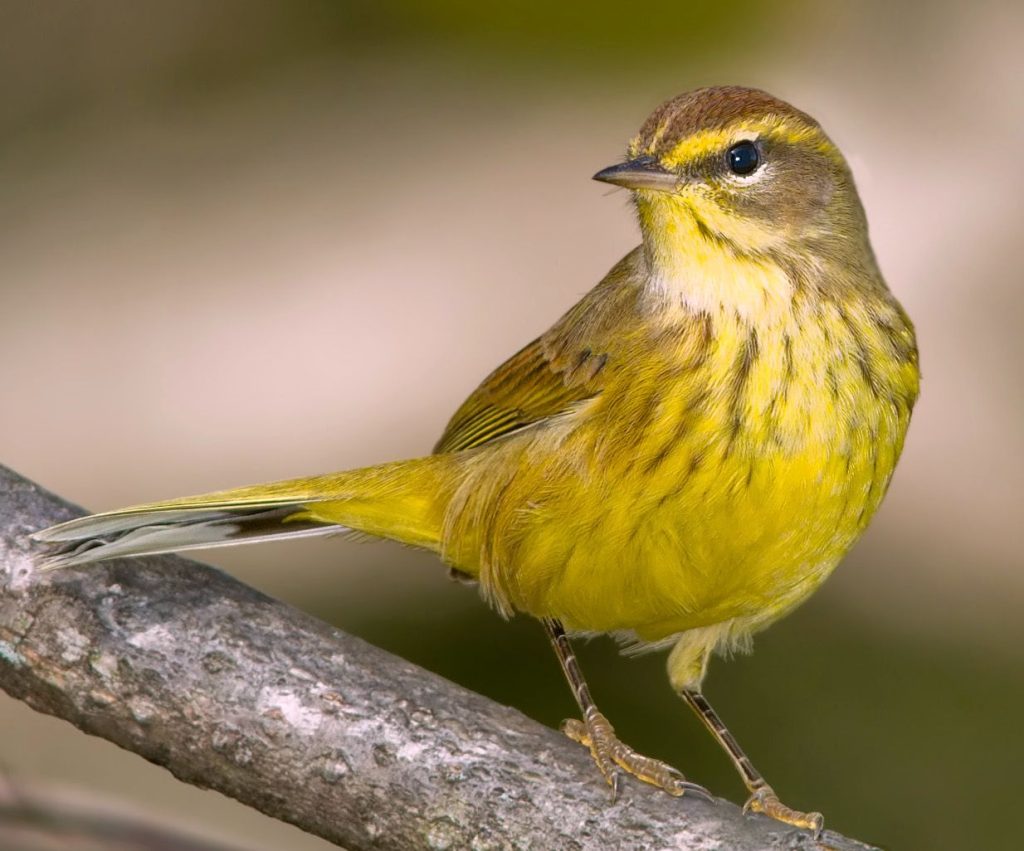
Palm Warblers can be seen in South Dakota during migration, primarily in April and May, as well as in September and October. They are recorded in 3% of checklists during migration periods.
These small, active birds have a brownish back, a bright yellow underpart, and a distinctive rusty cap on their heads. They also have a habit of wagging their tails while foraging.
Setophaga palmarum
Length: 4.7-5.5 in (12-14 cm)
Weight: 0.3-0.4 oz (8-11 g)
Wingspan: 7.9-9.1 in (20-23 cm)
Palm Warblers breed in the northern parts of North America, including Canada and Alaska. They migrate to the southeastern United States, the Caribbean, and Central America for the winter.
During migration, Palm Warblers can be found in a variety of habitats, including open woodlands, fields, and shrubby areas. They primarily feed on insects and occasionally consume berries and seeds.
For a sample of the Palm Warbler’s song, click on the provided link.
Nests of Palm Warblers are built on the ground in mossy areas, concealed beneath vegetation. The female constructs the nest using twigs, grass, and plant fibers, forming a cup-shaped structure. They lay 4 to 5 eggs, which require approximately two weeks to hatch.
To attract Palm Warblers to your yard during migration, provide a diverse habitat with open areas and shrubby vegetation, along with a water source.
Interesting fact: Palm Warblers are named for their frequent presence in palm trees during migration, where they can often be seen foraging for insects.
16. Scarlet Tanager
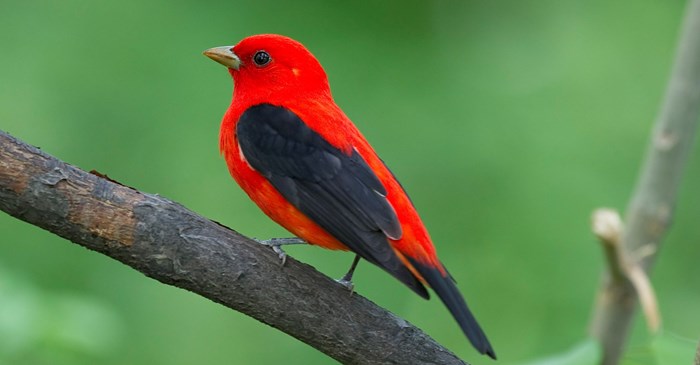
Scarlet Tanagers can be observed in South Dakota during the summer breeding season, from May to August. They are present in 3% of summer checklists.
These medium-sized birds are known for their vibrant plumage. Adult males display bright red bodies with black wings and tail. Females and immature individuals have olive-yellow plumage.
Piranga olivacea
Length: 6.3-7.1 in (16-18 cm)
Weight: 1.0-1.3 oz (28-37 g)
Wingspan: 9.8-10.6 in (25-27 cm)
Scarlet Tanagers breed in deciduous forests across the eastern and central parts of North America. They migrate to northern South America for the winter.
These birds prefer the canopy of mature forests, where they feed on insects, spiders, and occasionally consume fruits.
For a melodious sample of the Scarlet Tanager’s song, follow the provided link.
Nests of Scarlet Tanagers are built in trees, typically positioned high above the ground. The female constructs the nest using twigs, leaves, and grass, forming a cup-shaped structure. They lay 3 to 5 eggs, which require approximately two weeks to hatch.
To attract Scarlet Tanagers to your yard, provide a forested habitat with tall trees and a diverse insect population. Berry-producing trees and shrubs can also serve as additional food sources.
Interesting fact: Despite their vibrant red plumage, Scarlet Tanagers are often difficult to spot within the dense foliage of the forest canopy.
17. Blue-winged Warbler
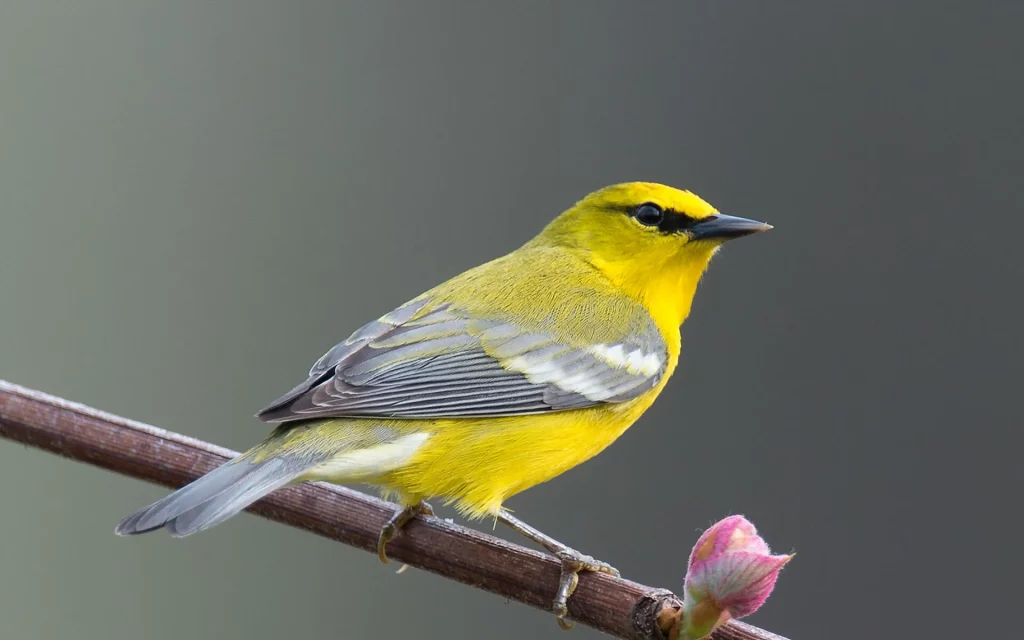
Blue-winged Warblers can be spotted in South Dakota during migration, primarily in May and September. They appear in 2% of checklists during migration periods.
These small, insect-eating birds have bright yellow bodies with blue-gray wings and a distinct white eye-ring.
Vermivora cyanoptera
Length: 4.7-5.1 in (12-13 cm)
Weight: 0.3-0.4 oz (8-11 g)
Wingspan: 7.5-8.3 in (19-21 cm)
Blue-winged Warblers breed across the eastern and central parts of the United States. They migrate to Central and South America for the winter.
During migration, Blue-winged Warblers can be found in a variety of habitats, including open woodlands, shrubby areas, and forest edges. They feed primarily on insects.
For a sample of the Blue-winged Warbler’s song, click on the provided link.
Nests of Blue-winged Warblers are built on or near the ground, usually concealed within vegetation. The female constructs the nest using leaves, grass, and plant fibers, forming a cup-shaped structure. They lay 3 to 7 eggs, which require around two weeks to hatch.
To attract Blue-winged Warblers to your yard during migration, provide a mix of shrubby and wooded areas, along with a water source.
Interesting fact: Blue-winged Warblers frequently hybridize with other warbler species, particularly the Golden-winged Warbler, resulting in hybrid offspring known as “Brewster’s Warblers” or “Lawrence’s Warblers.”
18. Lesser Goldfinch
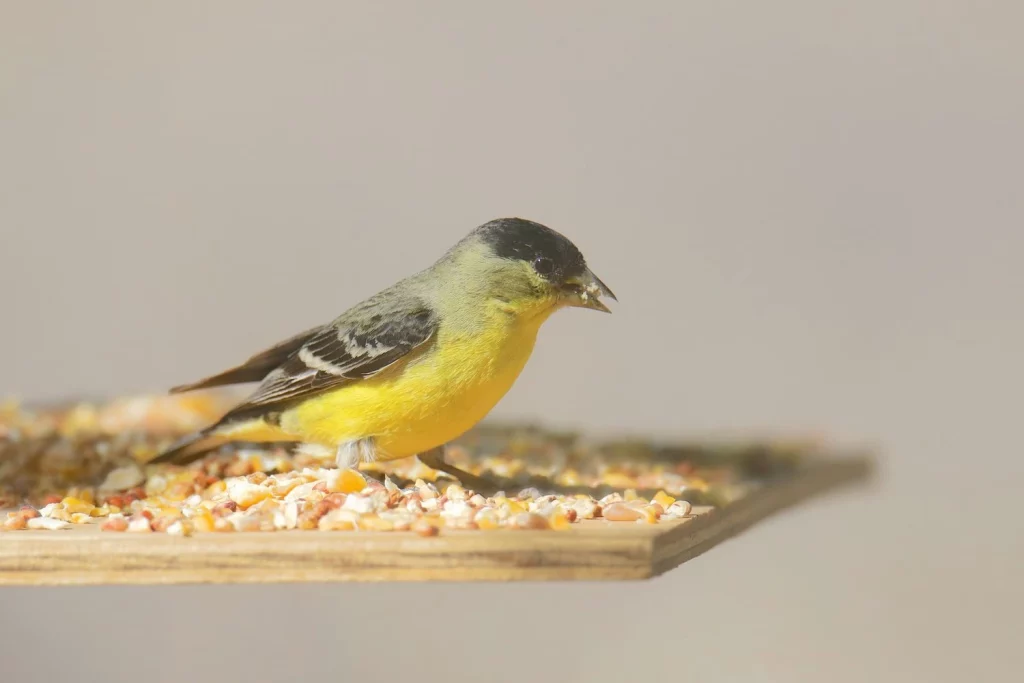
Lesser Goldfinches can be seen in South Dakota during the summer breeding season, primarily from May to August. They appear in 2% of summer checklists.
These small, lively birds are known for their black backs and bright yellow underparts. Males display a black cap on their heads, while females have a more olive-green appearance.
Spinus psaltria
Length: 4.3-4.7 in (11-12 cm)
Weight: 0.3-0.4 oz (9-11 g)
Wingspan: 7.1-7.9 in (18-20 cm)
Lesser Goldfinches breed in the southwestern parts of the United States and into Mexico. They are resident year-round in some parts of their range.
These birds inhabit a variety of habitats, including woodlands, scrublands, and gardens. They feed on seeds, especially from sunflowers and other composite plants.
For a delightful auditory experience of the Lesser Goldfinch’s song, listen to the provided link.
Nests of Lesser Goldfinches are built in shrubs or trees, often positioned several feet above the ground. The female constructs the nest using grass, plant fibers, and hair, forming a cup-shaped structure. They lay 3 to 6 eggs, which require approximately two weeks to hatch.
To attract Lesser Goldfinches to your yard, provide feeders with nyjer and sunflower seeds, as well as native plants that produce seeds and nectar.
Interesting fact: Lesser Goldfinches are known for their acrobatic feeding behavior, often hanging upside down from plants while foraging for seeds.
19. Orange-crowned Warbler

Orange-crowned Warblers can be observed in South Dakota during migration, primarily in May and September. They are present in 2% of checklists during migration periods.
These small, insect-eating birds have mostly olive-green plumage. They occasionally display an orange crown, although this feature is often concealed.
Leiothlypis celata
Length: 4.3-5.1 in (11-13 cm)
Weight: 0.3-0.4 oz (9-11 g)
Wingspan: 6.7-7.5 in (17-19 cm)
Orange-crowned Warblers breed across western North America, including parts of Canada and the United States. They migrate to southern United States, Mexico, and Central America for the winter.
During migration, Orange-crowned Warblers can be found in various habitats, including forests, woodlands, and shrubby areas. They feed on insects and occasionally consume berries.
For a sample of the Orange-crowned Warbler’s song, click on the provided link.
Nests of Orange-crowned Warblers are built on or near the ground, concealed within vegetation. The female constructs the nest using twigs, grass, and plant fibers, forming a cup-shaped structure. They lay 3 to 6 eggs, which require approximately two weeks to hatch.
To attract Orange-crowned Warblers to your yard during migration, provide diverse vegetation with dense shrubs and trees, along with a water source.
Interesting fact: The orange crown of the Orange-crowned Warbler is often hidden and rarely seen, leading to the misperception that they lack a distinct crown altogether.
20. Wilson’s Warbler

Wilson’s Warblers can be seen in South Dakota during migration, primarily in May and September. They appear in 2% of checklists during migration periods.
These small, insect-eating birds have bright yellow underparts, olive-green upperparts, and a distinctive black cap on their heads.
Cardellina pusilla
Length: 4.3-4.7 in (11-12 cm)
Weight: 0.3-0.4 oz (9-11 g)
Wingspan: 6.3-6.7 in (16-17 cm)
Wilson’s Warblers breed across the western parts of North America, from Alaska to the western United States and into Canada. They migrate to Mexico, Central America, and the Caribbean for the winter.
During migration, Wilson’s Warblers can be found in a variety of habitats, including forests, shrubby areas, and wetlands. They primarily feed on insects.
For a sample of the Wilson’s Warbler’s song, click on the provided link.
Nests of Wilson’s Warblers are built on or near the ground, usually concealed within vegetation. The female constructs the nest using grass, leaves, and plant fibers, forming a cup-shaped structure. They lay 4 to 6 eggs, which require approximately two weeks to hatch.
To attract Wilson’s Warblers to your yard during migration, provide a mix of dense shrubs, trees, and water sources.
Interesting fact: Wilson’s Warblers are known for their energetic foraging behavior, often flicking their wings and tails while searching for insects among vegetation.
21. Nashville Warbler
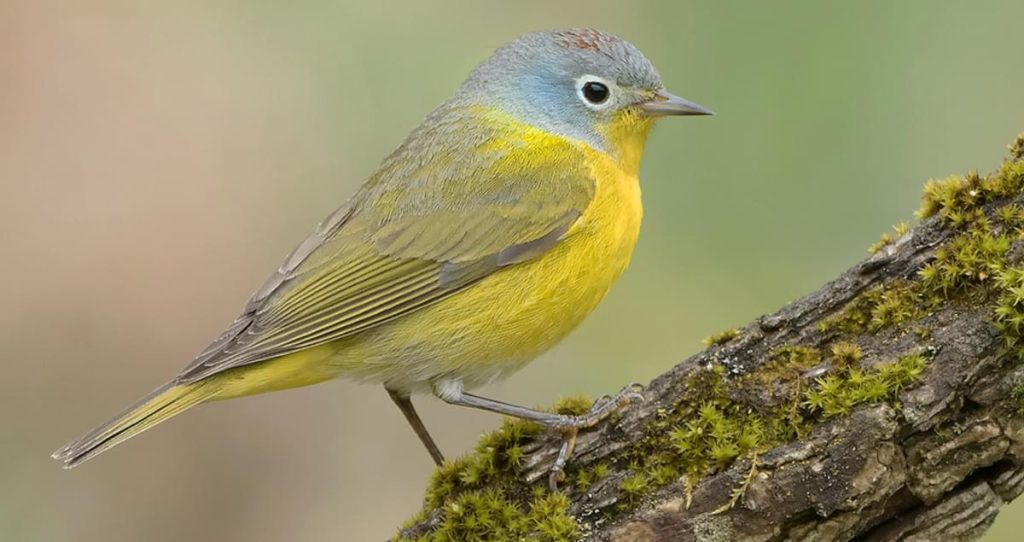
Nashville Warblers can be observed in South Dakota during migration, primarily in May and September. They are present in 2% of checklists during migration periods.
These small, insect-eating birds have yellow underparts, olive-green upperparts, and a gray hood on their heads. They also display a white eye-ring.
Leiothlypis ruficapilla
Length: 4.3-4.7 in (11-12 cm)
Weight: 0.3-0.4 oz (9-11 g)
Wingspan: 7.1-7.5 in (18-19 cm)
Nashville Warblers breed across the northern parts of North America, including Canada and parts of the United States. They migrate to Central America and the Caribbean for the winter.
During migration, Nashville Warblers can be found in a variety of habitats, including forests, woodlands, and shrubby areas. They feed on insects, spiders, and occasionally consume berries.
For a sample of the Nashville Warbler’s song, click on the provided link.
Nests of Nashville Warblers are built on or near the ground, concealed within vegetation. The female constructs the nest using twigs, grass, and plant fibers, forming a cup-shaped structure. They lay 4 to 5 eggs, which require approximately two weeks to hatch.
To attract Nashville Warblers to your yard during migration, provide a mix of trees, shrubs, and water sources.
Interesting fact: Nashville Warblers were named after Nashville, Tennessee, where the species was first discovered by naturalist Alexander Wilson.
22. Magnolia Warbler
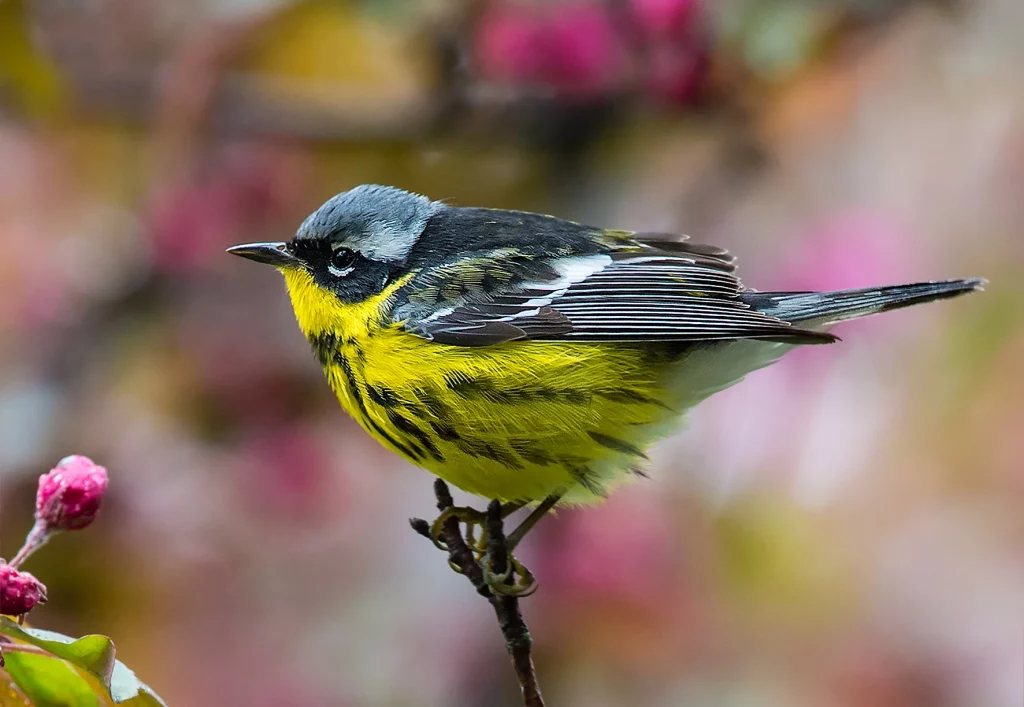
Magnolia Warblers can be seen in South Dakota during migration, primarily in May and September. They appear in 2% of checklists during migration periods.
These small, insect-eating birds have bright yellow underparts, olive-green upperparts, and a black mask on their faces. They also display a white wing patch and distinctive black streaks on their backs.
Setophaga magnolia
Length: 4.7-5.1 in (12-13 cm)
Weight: 0.4-0.5 oz (11-14 g)
Wingspan: 7.9-8.7 in (20-22 cm)
Magnolia Warblers breed across the northern parts of North America, including Canada and parts of the United States. They migrate to Mexico, Central America, and the Caribbean for the winter.
During migration, Magnolia Warblers can be found in various habitats, including forests, woodlands, and shrubby areas. They primarily feed on insects and occasionally consume berries.
For a melodious sample of the Magnolia Warbler’s song, follow the provided link.
Nests of Magnolia Warblers are built on or near the ground, concealed within vegetation. The female constructs the nest using grass, leaves, and plant fibers, forming a cup-shaped structure. They lay 4 to 5 eggs, which require approximately two weeks to hatch.
To attract Magnolia Warblers to your yard during migration, provide diverse vegetation with dense shrubs and trees, along with a water source.
Interesting fact: Despite their name, Magnolia Warblers do not have any particular association with magnolia trees and are more commonly found in coniferous forests.
23. Canada Warbler

Canada Warblers can be observed in South Dakota during migration, primarily in May and September. They are present in 2% of checklists during migration periods.
These small, insect-eating birds have bright yellow underparts, slate-gray upperparts, and a distinct necklace pattern of black streaks on their chests.
Cardellina canadensis
Length: 4.7-5.1 in (12-13 cm)
Weight: 0.4-0.5 oz (11-14 g)
Wingspan: 7.5-8.3 in (19-21 cm)
Canada Warblers breed across the northern parts of North America, including Canada and the northeastern United States. They migrate to northern South America for the winter.
During migration, Canada Warblers can be found in various habitats, including forests, woodlands, and shrubby areas. They primarily feed on insects.
For a sample of the Canada Warbler’s song, click on the provided link.
Nests of Canada Warblers are built on or near the ground, concealed within vegetation. The female constructs the nest using grass, leaves, and plant fibers, forming a cup-shaped structure. They lay 4 to 6 eggs, which require approximately two weeks to hatch.
To attract Canada Warblers to your yard during migration, provide a mix of trees, shrubs, and water sources.
Interesting fact: Canada Warblers have one of the longest migration journeys of any warbler species, traveling thousands of miles each year between their breeding and wintering grounds.
24. Black-throated Green Warbler

Black-throated Green Warblers can be seen in South Dakota during migration, primarily in May and September. They appear in 2% of checklists during migration periods.
These small, insect-eating birds have bright yellow underparts, olive-green upperparts, and a black throat and face. They also display white wing bars.
Setophaga virens
Length: 4.7-5.1 in (12-13 cm)
Weight: 0.3-0.4 oz (9-11 g)
Wingspan: 7.5-8.3 in (19-21 cm)
Black-throated Green Warblers breed across the northeastern parts of North America, from Canada to the northeastern United States. They migrate to Mexico, Central America, and the Caribbean for the winter.
During migration, Black-throated Green Warblers can be found in various habitats, including forests, woodlands, and shrubby areas. They feed on insects and occasionally consume berries.
For a sample of the Black-throated Green Warbler’s song, click on the provided link.
Nests of Black-throated Green Warblers are built on or near the ground, concealed within vegetation. The female constructs the nest using grass, leaves, and plant fibers, forming a cup-shaped structure. They lay 3 to 5 eggs, which require approximately two weeks to hatch.
To attract Black-throated Green Warblers to your yard during migration, provide diverse vegetation with dense shrubs and trees, along with a water source.
Interesting fact: Black-throated Green Warblers have a distinctive song that resembles the phrase “trees, trees, murmuring trees.”
25. Evening Grosbeak
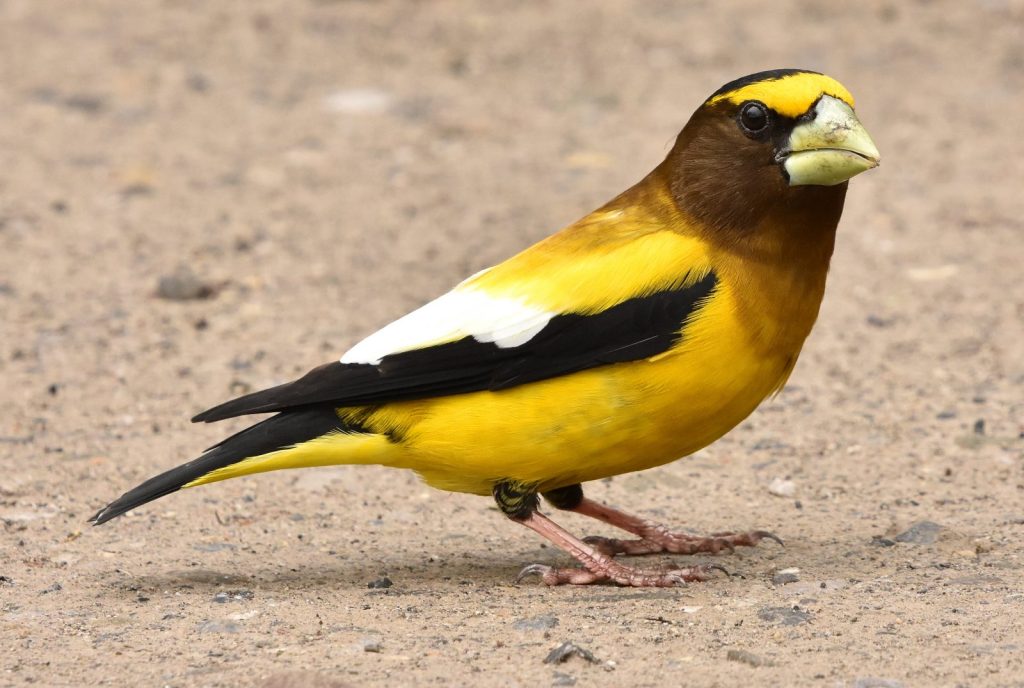
Evening Grosbeaks can be observed in South Dakota during migration, primarily in April and September. They are present in 2% of checklists during migration periods.
These large, seed-eating birds have a
stocky build with a large, conical bill. Adult males have bright yellow bodies with black wings and tail, while females have a more olive-green appearance.
Coccothraustes vespertinus
Length: 6.7-7.9 in (17-20 cm)
Weight: 1.9-2.6 oz (54-74 g)
Wingspan: 12.2-13.4 in (31-34 cm)
Evening Grosbeaks breed across the northern parts of North America, including Canada and parts of the United States. They are nomadic and can be found irregularly in various locations during winter.
These birds inhabit a variety of habitats, including coniferous and mixed forests. They primarily feed on seeds, especially those from trees such as spruce, fir, and pine.
For a sample of the Evening Grosbeak’s call, click on the provided link.
Nests of Evening Grosbeaks are built in trees, typically positioned high above the ground. The female constructs the nest using twigs, grass, and plant fibers, forming a cup-shaped structure. They lay 2 to 4 eggs, which require approximately two weeks to hatch.
To attract Evening Grosbeaks to your yard, provide feeders with sunflower seeds and other seeds, as well as native trees that produce abundant seeds.
Interesting fact: Evening Grosbeaks have a unique feeding behavior known as “leaf flipping,” where they use their bill to flip leaves and search for insects underneath.
26. Cape May Warbler
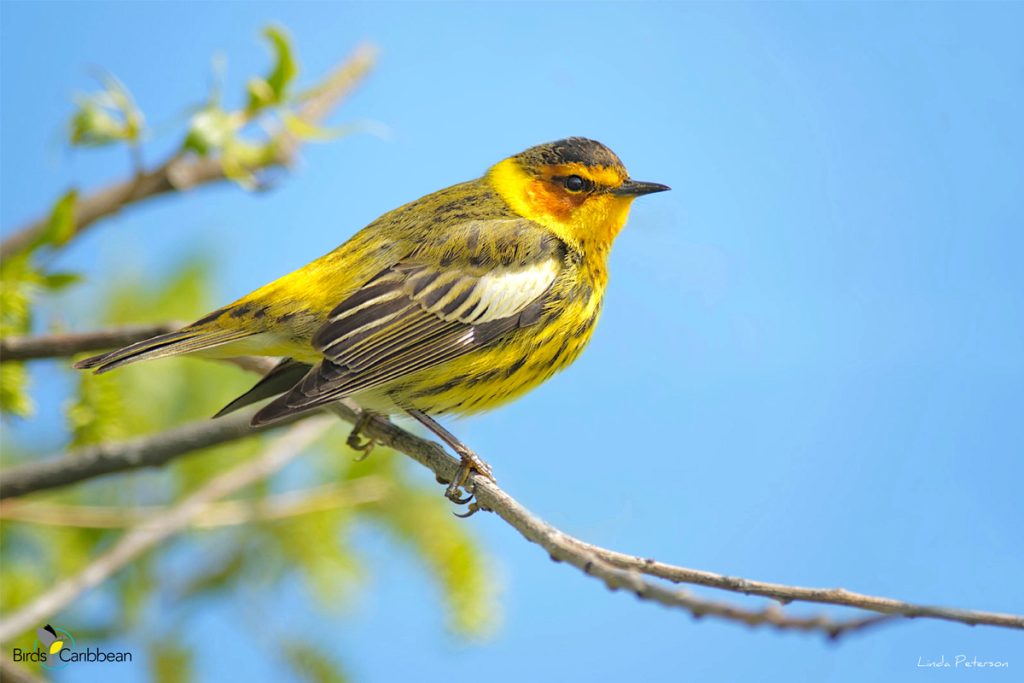
Cape May Warblers can be seen in South Dakota during migration, primarily in May and September. They appear in 2% of checklists during migration periods.
These small, insect-eating birds have bright yellow underparts with distinctive reddish-brown streaks on their sides. They also display a yellow face with black streaks and a bold black patch on their chest.
Setophaga tigrina
Length: 4.7-5.1 in (12-13 cm)
Weight: 0.4-0.5 oz (11-14 g)
Wingspan: 7.9-8.7 in (20-22 cm)
Cape May Warblers breed across the northern parts of North America, including Canada and parts of the northeastern United States. They migrate to the Caribbean, Central America, and northern South America for the winter.
During migration, Cape May Warblers can be found in various habitats, including forests, woodlands, and shrubby areas. They primarily feed on insects, especially during their breeding season.
For a melodious sample of the Cape May Warbler’s song, follow the provided link.
Nests of Cape May Warblers are built in trees, typically in coniferous or mixed forests. The female constructs the nest using grass, moss, and plant fibers, forming a cup-shaped structure. They lay 4 to 7 eggs, which require approximately two weeks to hatch.
To attract Cape May Warblers to your yard during migration, provide diverse vegetation with a mix of trees and shrubs, along with a water source.
Interesting fact: Cape May Warblers have a unique feeding behavior where they extract nectar from flowers by piercing the base of the flower and sipping the liquid using their specialized tongue.
27. Pine Warbler
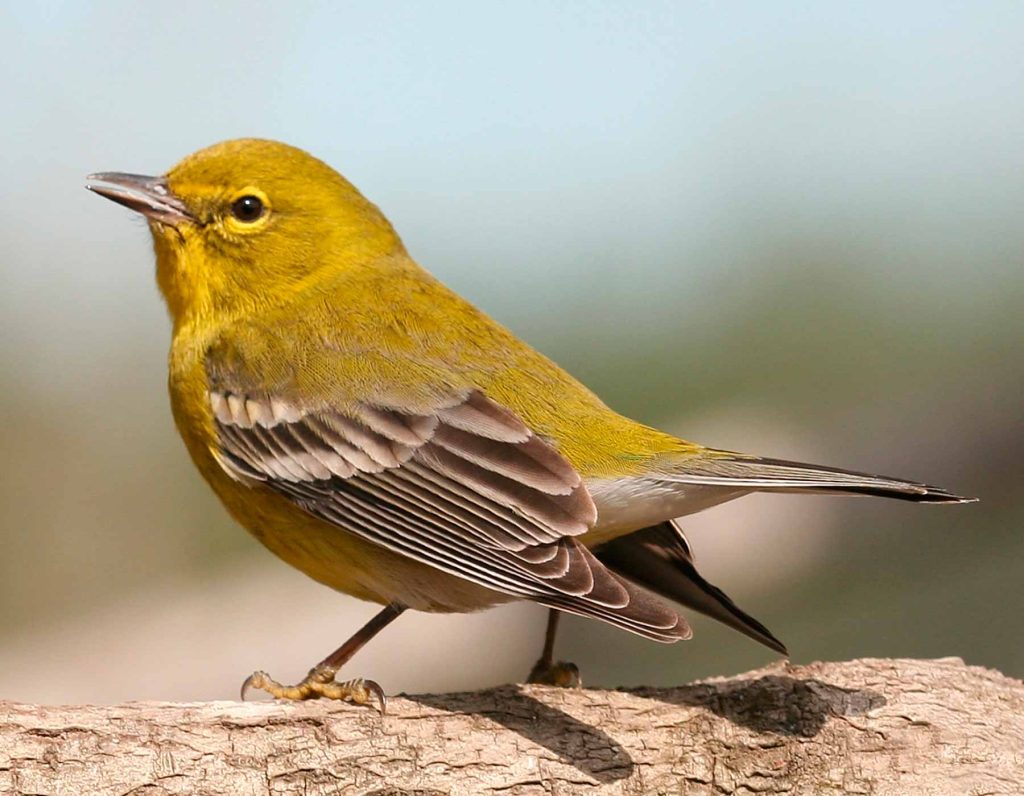
Pine Warblers can be observed in South Dakota during migration, primarily in April and September. They are present in 2% of checklists during migration periods.
These medium-sized, insect-eating birds have olive-green upperparts and pale yellow underparts. They often have a faint, blurry streaking on their sides and chest.
Setophaga pinus
Length: 4.7-5.5 in (12-14 cm)
Weight: 0.3-0.4 oz (9-11 g)
Wingspan: 7.9-8.7 in (20-22 cm)
Pine Warblers breed across the southeastern parts of North America, including the southeastern United States. They migrate to the southern United States and northern Mexico for the winter.
During migration, Pine Warblers can be found in various habitats, including pine forests, mixed woodlands, and scrubby areas. They primarily feed on insects, spiders, and occasionally consume seeds.
For a sample of the Pine Warbler’s song, click on the provided link.
Nests of Pine Warblers are built in pine trees, typically positioned high above the ground. The female constructs the nest using twigs, grass, and plant fibers, forming a cup-shaped structure. They lay 3 to 5 eggs, which require approximately two weeks to hatch.
To attract Pine Warblers to your yard during migration, provide a mix of trees and shrubs, especially pine trees, along with a water source.
Interesting fact: Pine Warblers are known for their ability to sing while hovering in mid-air, a behavior called “hover-singing,” which is rare among songbirds.
28. Prothonotary Warbler
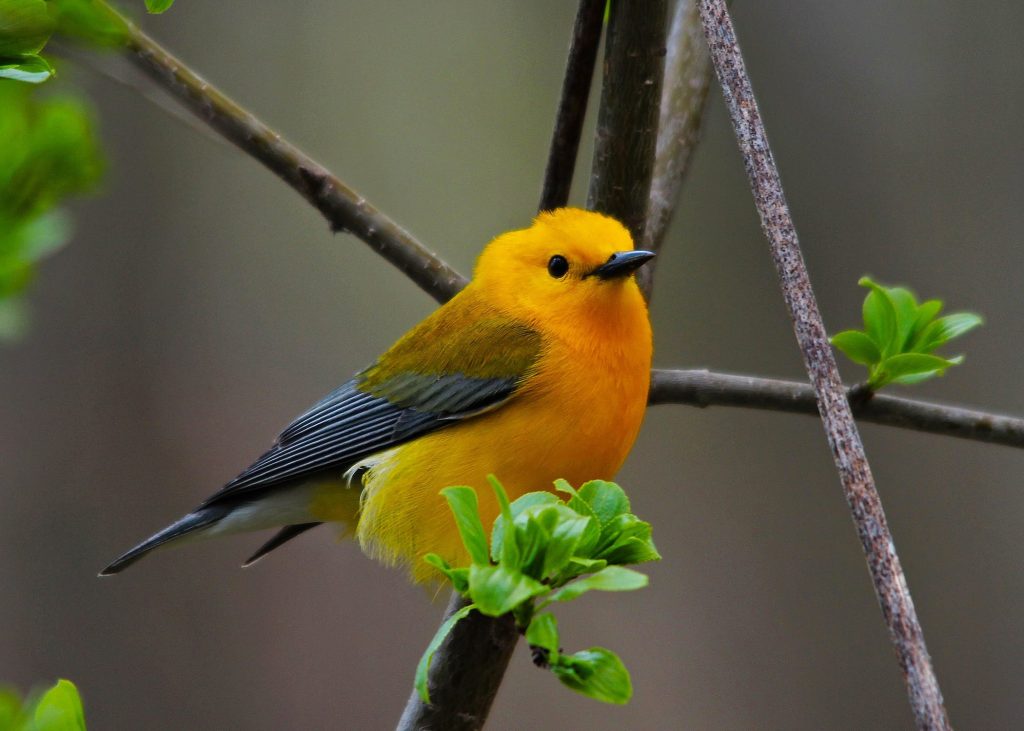
Prothonotary Warblers can be seen in South Dakota during migration, primarily in May and September. They appear in 2% of checklists during migration periods.
These small, insect-eating birds have bright yellow bodies with a bluish-gray back and wings. They also display a distinctive orange-yellow head and a long, thin beak.
Protonotaria citrea
Length: 4.7-5.1 in (12-13 cm)
Weight: 0.4-0.5 oz (11-14 g)
Wingspan: 7.9-8.7 in (20-22 cm)
Prothonotary Warblers breed across the southeastern parts of North America, including the eastern United States. They migrate to Central America and northern South America for the winter.
During migration, Prothonotary Warblers can be found in various wetland habitats, including swamps, marshes, and riverbanks. They primarily feed on insects and occasionally consume berries.
For a melodious sample of the Prothonotary Warbler’s song, follow the provided link.
Nests of Prothonotary Warblers are built in tree cavities or nest boxes near water, typically positioned close to the ground. The female constructs the nest using grass, moss, and plant fibers, forming a cup-shaped structure. They lay 4 to 6 eggs, which require approximately two weeks to hatch.
To attract Prothonotary Warblers to your yard during migration, provide nest boxes near water sources, along with a mix of trees and shrubs.
Interesting fact: Prothonotary Warblers are one of the few warbler species that readily use nest boxes, and providing suitable nesting sites can help support their populations.
29. Yellow-throated Vireo

Yellow-throated Vireos can be observed in South Dakota during migration, primarily in May and September. They are present in 2% of checklists during migration periods.
These medium-sized songbirds have olive-green upperparts and bright yellow underparts with a contrasting black and white pattern on their wings. They also display a yellow throat and spectacles around their eyes.
Vireo flavifrons
Length: 5.9-6.7 in (15-17 cm)
Weight: 0.5-0.6 oz (14-17 g)
Wingspan: 9.4-10.2 in (24-26 cm)
Yellow-throated Vireos breed across the eastern parts of North America, including the southeastern United States. They migrate to Mexico, Central America, and northern South America for the winter.
During migration, Yellow-throated Vireos can be found in various habitats, including deciduous forests, woodlands, and riverbanks. They primarily feed on insects and occasionally consume berries.
For a sample of the Yellow-throated Vireo’s song, click on the provided link.
Nests of Yellow-throated Vireos are built in the forks of tree branches, typically positioned at medium heights. The female constructs the nest using grass, plant fibers, and spider silk, forming a cup-shaped structure. They lay 3 to 5 eggs, which require approximately two weeks to hatch.
To attract Yellow-throated Vireos to your yard during migration, provide a mix of trees and shrubs, especially deciduous trees, along with a water source.
Interesting fact: Yellow-throated Vireos are known for their distinctive song, which has been described as a series of musical phrases that resemble the phrase “here I am.”
